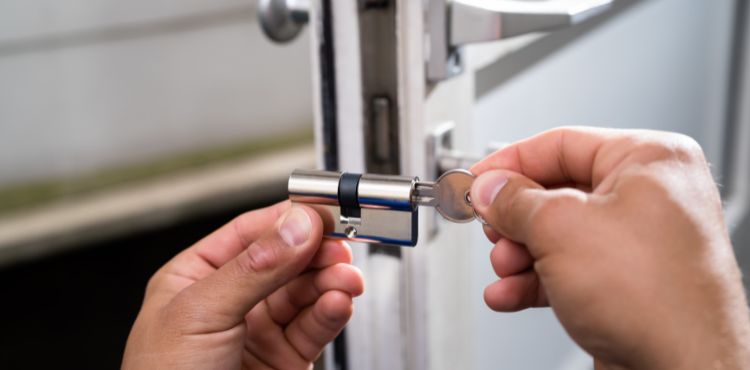When selecting a lock for your home, business, or belongings, it’s important to consider the weight. A lock’s weight impacts how you install it, carry it, and use it. The weight also gives clues about the lock’s durability, materials, and security level.
I recently discussed this topic with my friend Rob, who is an expert in locksmith and owns . Rob explained to me that lock weight is an important factor many customers overlook when choosing new locks.
In this article, we’ll look at approximate weights for common lock types so you can make an informed decision and choose the right lock for your needs.
Explanation of the importance of weight in choosing a lock
A lock’s weight is an important factor because it impacts:
Installation – Heavier locks require more robust mounting hardware and attachment points to support them securely. Lighter locks are easier to install on doors or in equipment.
Portability – If you need to transport the lock, a lighter one will be easier to carry and move around. Heavier locks can become a burden over time.
Usage – Repeatedly operating a heavier lock can become tiring compared to a lighter one. Consider who will be using the lock most often.
Durability – More substantial, heavier locks often indicate better construction with sturdier materials that resist damage. Lighter locks may be more prone to failure over time.
Security Level – Weight frequently correlates with the security level of the lock. More sophisticated security features like drill-resistant plates add weight in higher security locks.
Considering the weight early in your selection process will help you choose the optimal lock for your particular situation. A lock shouldn’t be too light or too heavy for its intended application.
Overview of Different Types of Locks and Their Weights

Padlocks
Padlocks come in a range of sizes, with smaller, lighter options around 0.092 kg (3 oz) up to larger, heavier locks around 0.20 kg (7 oz). Key factors in padlock weight include shackle diameter, body width, and materials used.
Deadbolts
Deadbolts for exterior doors often weigh 0.5-1 pound. Interior privacy deadbolts weigh slightly less, around 0.25-0.5 lbs. The grade of the bolt mechanism and inclusion of security features affect deadbolt weight.
Knob Locks
Standard interior knob locks typically weigh 14-17 oz. Important factors are the grade of levers/knobs and the complexity of the locking mechanism inside. High-end knob locks can weigh slightly more.
Lever Handle Locks
Exterior lever handle locks weigh in the range of 3-4 pounds due to sturdy materials and sophisticated locking mechanisms. Interior lever handles are lighter around 1-2 pounds. The number and type of levers impact overall weight.
Cam Locks
Cam locks are estimated to weigh between 1-2 pounds depending on the material (steel vs. brass), size, keying options, and level of security. More advanced cam locks tend to be heavier.
Rim/Mortise Locks
Standard rim and mortise locks weigh 0.4-0.8 lbs. High security mortise locks can range from 2-3 pounds due to reinforced materials and cylinders. The more security features added, the heavier mortise locks become.
Euro Profile Cylinders
Euro profile cylinders are light, weighing just 270-350 grams on average. This compact cylindrical design has fewer moving parts, keeping the weight down.
Wall Mounted Locks
Typical wall mounted locks like push button locks weigh 1-1.2 lbs. Material, size, and included electronics impact overall weight. More durable materials like steel increase weight.
Interchangeable Core (IC) Cylinders
IC lock cylinders tend to be heavier, in the 8-12 pound range, because they must be durable enough for the core to be removed and swapped out. The modular metal housings add weight over standard cylinders.
Furniture Locks
Small profile furniture locks designed for cabinets, drawers, etc. are light, weighing just 10-13 oz on average. This keeps them unobtrusive and easy to operate.
Vending/T-Handle Locks
The wide cylindrical T-handle design of vending and T-handle locks contributes to a higher weight around 1.41 pounds normally. Materials like hardened steel add density.
Jimmy Proof Deadbolts
Extra security jimmy proof deadbolts have reinforced strike plates and tapered cylinders adding marginal weight, typically just an extra ounce or less over standard deadbolts.
Rim Latch Locks
Basic rim latch locks are light due to simple design. On average they weigh only 35 grams (1.2 oz). Material affects weight – steel vs. brass – but size is relatively small.
Key In Knob (KIK) Cylinders
KIK cylinders weigh approximately 0.56 pounds. The self-contained cylinder and knob configuration results in a compact, light design.
Other Locks
Weight can vary widely depending on the type and complexity of the lock. Simple latch or padlocks may weigh just a few ounces. Sophisticated commercial grade locks can weigh several pounds due to advanced materials and electronics.
Factors Affecting Lock Weight
Materials used – Steel, solid brass, or titanium will add weight over plastic or lightweight alloys.
Construction quality – Commercial grade, high security locks are constructed with sturdier materials that increase density.
Lock type – Deadbolts, mortise locks, high security padlocks will weigh more than simple padlocks or cabinet locks.
Size/dimensions – Larger locks designed for thick doors will be heavier than small, compact locks.
Number of levers/knobs – Additional lock inputs like levers or knobs will increase overall weight.
Security features – Reinforced strike plates, drill protection, bump/pick resistance features will increase density.
Electronic components – Digital locks with keypads, touchscreens, etc. will weigh more due to electronics.
Material Used in Construction
Steel: The most common lock material, provides strength and durability. Adds significant weight.
Solid Brass: Attractive finish but heavier than steel. Used for higher end locks.
Titanium: Extremely strong yet lightweight metal. Reduces weight while maintaining strength.
Aluminum: Lightweight but less strong than steel. Used more for lever handles and decorative covers.
Zinc/Pot Metal Alloys: Low density alloys with a silver color. Common in cheap, lightweight locks.
Plastic: Used for internal components and lock bodies. Contributes negligible weight but vulnerable to damage.
Wood: Occasionally used in older or handcrafted padlock bodies. Relatively light but not very durable.
The optimal material balances weight, strength, durability, and appearance. Steel strikes the best balance for most locks, with solid brass a stylish but heavy option. Lightweight metals like titanium reduce weight while maintaining security.
Related Post: What Weighs 1000 Grams(1 KG)? Top Household Items
Final Words
In summary, lock weights can vary considerably based on the type, size, materials, and included security features. Standard interior door locks tend to be lighter, while exterior door locks need to be more heavy-duty.
Locks designed for high-security applications will have more heft due to sturdy construction. Materials make a difference too, with solid steel and brass adding density over lightweight alloys or polymers. While it’s difficult to pinpoint exact weights, keeping the general range for different lock types in mind will help guide your selection process.
A lock that’s too heavy or too light for the intended use can lead to headaches down the road. Considering the lock’s weight along with appearance, installation requirements, security level, and usage needs will ensure you make the optimal choice. If you are still confused about the lock weight for your situation, consult a locksmith in your area.

